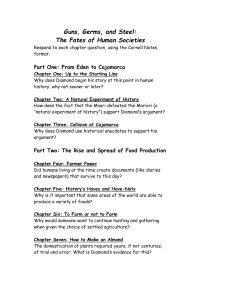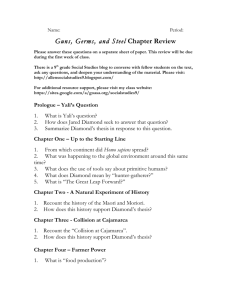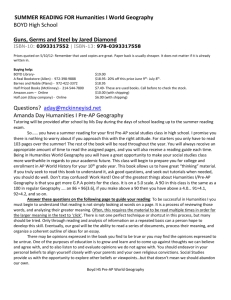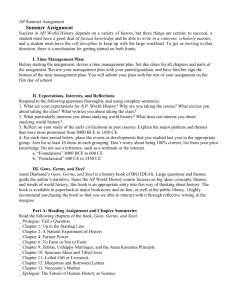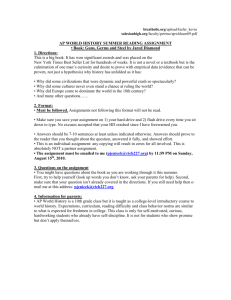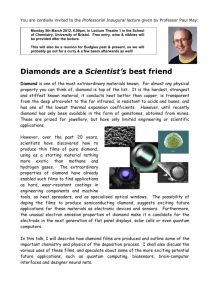SRG - Guns Germs Steel
advertisement
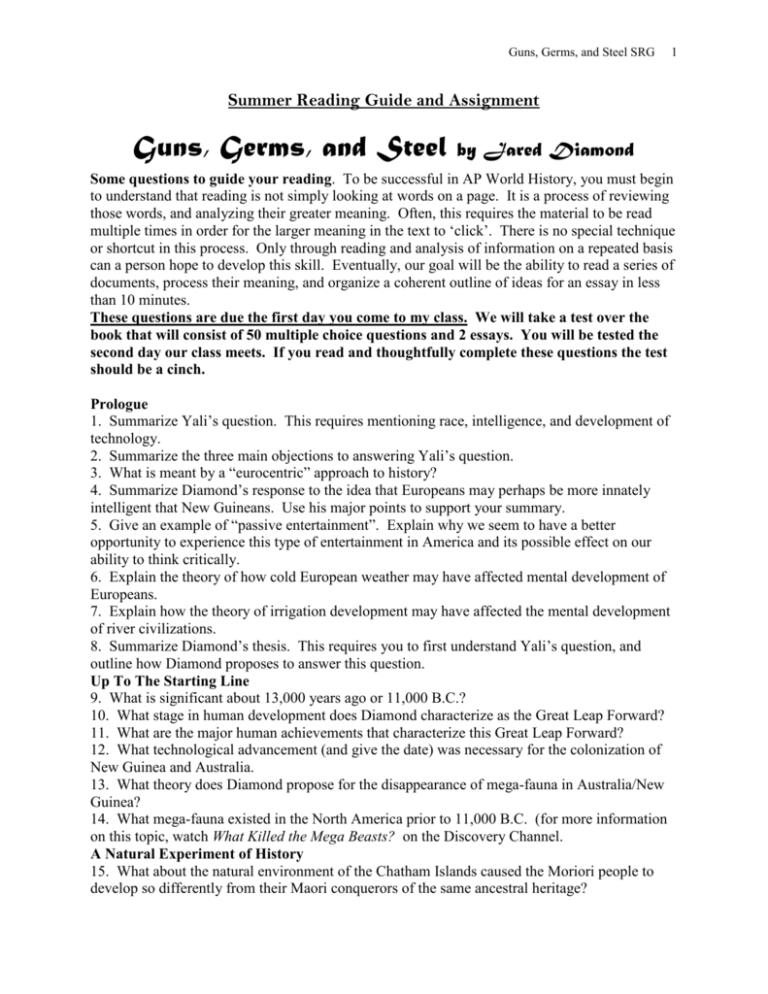
Guns, Germs, and Steel SRG 1 Summer Reading Guide and Assignment Guns, Germs, and Steel by Jared Diamond Some questions to guide your reading. To be successful in AP World History, you must begin to understand that reading is not simply looking at words on a page. It is a process of reviewing those words, and analyzing their greater meaning. Often, this requires the material to be read multiple times in order for the larger meaning in the text to ‘click’. There is no special technique or shortcut in this process. Only through reading and analysis of information on a repeated basis can a person hope to develop this skill. Eventually, our goal will be the ability to read a series of documents, process their meaning, and organize a coherent outline of ideas for an essay in less than 10 minutes. These questions are due the first day you come to my class. We will take a test over the book that will consist of 50 multiple choice questions and 2 essays. You will be tested the second day our class meets. If you read and thoughtfully complete these questions the test should be a cinch. Prologue 1. Summarize Yali’s question. This requires mentioning race, intelligence, and development of technology. 2. Summarize the three main objections to answering Yali’s question. 3. What is meant by a “eurocentric” approach to history? 4. Summarize Diamond’s response to the idea that Europeans may perhaps be more innately intelligent that New Guineans. Use his major points to support your summary. 5. Give an example of “passive entertainment”. Explain why we seem to have a better opportunity to experience this type of entertainment in America and its possible effect on our ability to think critically. 6. Explain the theory of how cold European weather may have affected mental development of Europeans. 7. Explain how the theory of irrigation development may have affected the mental development of river civilizations. 8. Summarize Diamond’s thesis. This requires you to first understand Yali’s question, and outline how Diamond proposes to answer this question. Up To The Starting Line 9. What is significant about 13,000 years ago or 11,000 B.C.? 10. What stage in human development does Diamond characterize as the Great Leap Forward? 11. What are the major human achievements that characterize this Great Leap Forward? 12. What technological advancement (and give the date) was necessary for the colonization of New Guinea and Australia. 13. What theory does Diamond propose for the disappearance of mega-fauna in Australia/New Guinea? 14. What mega-fauna existed in the North America prior to 11,000 B.C. (for more information on this topic, watch What Killed the Mega Beasts? on the Discovery Channel. A Natural Experiment of History 15. What about the natural environment of the Chatham Islands caused the Moriori people to develop so differently from their Maori conquerors of the same ancestral heritage? Guns, Germs, and Steel SRG 2 16. What are the three staple domesticated animals of the Polynesians? 17. What are the main causes of low human population density in many Polynesian islands? 18. What man-made constructions allowed for increased human population density in islands such as Hawaii? Collision at Cajamarca 19. If you had witnessed Cajamarca prior to the overthrow of Atahuallpa, explain why you may not have believed Pizarro’s overthrow of the Incas was possible. 20. Explain the role of technology in the overthrow of the Inca. 21. Explain the role of religion in the overthrow of the Inca. 22. Explain the role of disease in the overthrow of the Inca. 23. Explain the role of literacy and government organization in the overthrow of the Inca. Farmer Power 24. Using the chart on 87, explain which of the five proximate factors is the most important product on an agricultural society. 25. Explain how an agricultural society naturally provides the opportunity to develop the proximate factors. 26. List all of the economic products and services provided by the following agriculture and livestock: a. cotton b. flax c. hemp d. camel e. horse f. donkey g. cow h. water buffalo i. Goat 27. How does animal domestication affect plant (corn) production? (at least 2) 28. In what ways do animals affect military success? 29. Name the date and the invention that make horses a viable military option. History’s Haves And Have Nots 30. List the three areas of the world that are the earliest “haves”. 31. List the three places of the world that are the later “haves” 32. List the three areas of the world that borrowed the stuff of the “haves” earliest. 34. Make a statement about the relative location in approximation to each other of the haves in #30 to the borrowers in #34. To Farm Or Not To Farm 35. What are the four major factors that allowed farmers to dominate hunters and gatherers? How To Make An Almond 36. Use an example that explains how the tastier plants we have today went through the process of natural selection. 37. Give five examples of different characteristics a plant could possess to allow it to be naturally selected. 38. How did the industrial revolution affect the moth population in England? 39. How and where were the fruit trees we have today such as cherries and apples developed for agriculture? 40. Why were almond trees domesticated for consumption but oak trees were not? Apples or Indians 41. What are the major advantages of the fertile crescent that predispose this region to early agricultural development? 42. What is the major key to plant success regarding pollination and how did this affect the fertile crescent? 43. Why are barley and emmer wheat the two best grasses to domesticate? Guns, Germs, and Steel SRG 3 44. What are the three major limiting factors that encourage the hunter-gatherer lifestyle on New Guinea to continue long after other areas have turned to agriculture? 45. Based upon the preceding chapter, explain why it is best to characterize Diamond as a cultural or an environmental historian. (which does he see as the driving force in history) Zebras and Unhappy Marriages 46. Why did Africans domesticate Eurasian animals when they had a food source equivalent to a modern zoo in their backyard? In other words, what’s up with those Zebras? 47. You need to make a cute copy of page 167. Use markers and have fun. You will refer to it for the rest of the year. This will become vitally essential to you exactly one year from now. 48. Explain the many different characteristics of the Anna Karenina principle. Spacious Skys and Tilted Axes 49. Explain the advantage of an east-west continental axis. 50. How does the north-south axis prevent diffusion of crops? Lethal Gift of Livestock 51. What evolutionary benefit do microbes derive from making humans sick in bizarre ways such as genital sores or diarrhea? 52.Give an example how the evolutionary process of natural selection has resulted in immunity to certain diseases. 53.What are the four characteristics of “epidemic” diseases that cause them to die out and not reappear for a long period of time? 54.Why does it make sense that slow developing/spreading diseases such as leprosy, polio, etc. must be the oldest diseases in the history of mankind? 55. What aspects of farming civilizations make them more adept at sustaining the development of infectious crowd diseases? 56. Explain why the exchange of diseases from the old world (Europe) and the new world (America) was so one-sided (America got killed off, not Europe). In doing so, make sure to explain exactly what is a “social” animal. Blueprints and Borrowed Letters 57. What is the importance of a writing system to a civilization? 58. How does the development of a writing system fit into the larger thesis of Guns, Germs, and Steel? In other words, how did writing systems develop differently in Eurasia than other continents? Necessity’s Mother 59. How does Edison’s phonograph help disprove the theory of necessity as the mother of invention? 60. If you believe in Diamond’s theory, which is more important: the ability to invent, or the ability to borrow inventions and find new uses? 61. Once again we visit Diamond’s thesis. How does geography effect the ability to adapt and refine inventions for use? From Egalitarianism to Kleptocracy 62. Reading between the lines. Diamond’s religious beliefs should be transparent after reading this chapter. Give a brief analysis of how useful he deems religion for the average Joe in society. 63. Besides maintaining the status quo of kleptocracy, how else does religion in a practical sense, serve society These two questions are for the extremely intellectual only! Guns, Germs, and Steel SRG 4 64. How does the Diamond’s perception of the function of religion in a kleptocracy make the mission for Catholics difficult? This should help explain why our task of spreading the good news of Jesus Christ is not relegated only to distant tribes in the jungle. 65. After looking at this website http://www.usccb.org/sdwp/scattering.htm Explain why the Catholic church is either useful or troublesome for the maintenance of a kleptocracy in the United States. Yali’s People 66. Why were Europeans able to replace the Aboriginal Australians but not the natives of New Guinea? How China Became Chinese 67. What major factor of unification allows for a smooth flow of technology and crops from all parts of East Asia? 68. What geographic difference in China was easier to overcome than it was in other areas such as the Americas and Africa? Speedboat to Polynesia 69. Describe the “speedboat” that was used to get to Polynesia. 70. Summarize the dates and cultures that were transported during the Polynesian migrations. (this is big stuff for the AP examination) Hemispheres Colliding 71. Back to the thesis. What were the four reasons the Eurasians were able to conquer the Americans after 1492? 72. What is the most important factor in this conquest? Why? 73. Make a small chart that shows the flow of crops that went to Europe from America and viceversa in the Columbian Exchange. 73. Why did the Vikings fail to conquer the Americas and the Spanish succeeded? How Africa Became Black 74. Why is the American conception of race in Africa useless? 75. What advantages enabled the Bantu to replace the Pygmies and Khoisan? 76. What are the dates and locations of the Bantu migrations? 77. How did the Europeans conquer and enslave the Africans, not the other way around? 78. What major barrier divides Africa from Eurasia? Epilogue 79. Back to the thesis. Do you agree with how Diamond answers Yali’s question? 80. O.K. so Eurasia it is. If that is the case, why Europe over the Middle East? 81. More importantly, why Europe over China? Everything remotely intelligent and useful came from there anyway, right? 82. Explain why there is or is not a basis for studying individuals, inventions, and specific events in history. 83. Let’s say you disagree with Diamond’s thesis. What are the important factors in the development of civilization. Which is the most important?
